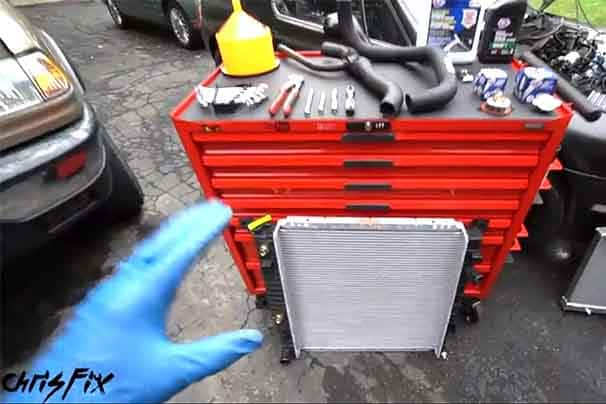Source | Getty
There’s one sure-fire way to ruin your day, engine, reputation under the hood, and road trip this summer. It’s fast, requires virtually no effort or planning, and happens to countless drivers every day. All you have to do is let your engine overheat because of insufficient cooling.
In this instance, I’m not talking about the more common, run-of-the-mill catastrophes usually behind a cooling system failure, including broken hoses or belts, insufficient coolant level, water pump or thermostat failure, or foreign object piercing the radiator. Less dramatic, but equally effective at causing an engine to overheat, are scenarios in which a vehicle’s cooling system can’t dissipate enough heat fast enough to prevent an overheated engine.
In most cases, it’s the result of an efficiency issue, even when everything on the cooling system is working properly. In other situations, modifications designed to coax more horsepower from the engine might also require changes to the cooling system because more horsepower usually equates to more heat generated. Here’s a look at several add-on solutions to prevent engine overheating.
1. Performance radiator
 Car radiator
Car radiator
There’s a reason copper and brass have historically been materials of choice in vehicle radiators. Copper is great when it comes to thermal conductivity, performing 50 percent better than radiator fins made from aluminum. And brass is durable. So why are aluminum radiators becoming all the rage in high-performance engines and even among vehicle manufacturers?
Weight.
Aluminum radiators weigh 10 to 15 pounds less than traditional radiators. And they compensate for the reduction in their material’s thermal conductivity with increased radiator surface area and coolant capacity, design, fin spacing and even tube size. The larger the radiator’s surface area translates to greater airflow reaching more coolant, which means improved cooling capability.
The limiting factor here is the amount of space you have or can create in which to shoehorn in a larger radiator. Most radiators utilize a single-pass design – hot coolant comes in one side of the radiator, passes through, and exits out the opposite side.
For increased cooling capacity, look at a dual-pass, horizontal-flow radiator. With this design, coolant passes through one half of the radiator, but instead of exiting, it then passes through the other half of the radiator, essentially making two passes instead of one. Moving to a dual-pass radiator will probably also require a water pump upgrade because this radiator design places more demand on the pump.
And that brings us to the topic of coolant speed. An aluminum radiator with larger diameter tubes is going to require an increase in the speed at which the water pump is moving coolant through the system. Your muscle car’s pulley-pump speed might have been sufficient when everything was stock from the factory, but any modifications made might now require changes to that speed and ratio. In addition to tube size, high-performance aluminum radiators also have more fins that are spaced closer together for increased heat transfer from the coolant to the atmosphere.
2. Electric fans
Engine-driven fans can get the job done when you’re tooling down the highway at cruising speeds, but when you’re idling or fighting stop-and-go traffic – not so much.
For increased cooling capacity, consider installing an electric fan, or two. Unlike an engine-driven fan, an electric fan is going to generate enough airflow to sufficiently help cool the engine, regardless of engine RPMs or traveling speed. In addition to consistent airflow, electric fans can also net you more horsepower.
It’s estimated that engine-driven fans steal about 35 horsepower and clutch-driven fans about half that amount, while electric fans only take about one horsepower. Installing a dual-fan set up enables the entire radiator surface to be covered with cooling air flow.
Another option is to use a two-fan system, but with one fan stationed in front of the radiator, pushing air to it, and a second fan behind the radiator, pulling air to it – remembering that pulling is always more efficient than pushing. As for fan blade style, that depends on what’s more important to you: cooling or noise levels. Curved-bladed fans are quieter than straight-blade fans, but they don’t move as much air. And in what’s probably beginning to sound like a reoccurring theme, a changeover from an engine-drive fan to an electric one might also require some beefing up of the vehicle’s electrical system to ensure it’s up to the task and increased loads.
3. Fan shroud
If you’re making the effort of adding an electric fan, make sure you go all the way and include an aluminum fan shroud. The right fan shroud can maximize the fan’s heat-reduction capacity by delivering cooling air to nearly every square inch of the radiator surface, while choosing aluminum helps deliver further weight reduction.
4. Type of coolant
When it comes to the liquid flowing through the radiator, nothing’s better at heat transfer than plain old water. Unfortunately nothing also beats water when it comes to freezing in winter and destroying your engine, and corroding the radiator and inflicting a similar level of carnage there.
If you are running straight water for coolant – some racing series require this – be sure to also include an anti-corrosion additive to the mix, and to take the necessary steps to prevent freezing before lower temperatures arrive. You’ll also need to research the benefits of using softened water if this is the somewhat risky route you choose to go.
If, however, you choose to play it safe by using traditional antifreeze, also consider an additive, such as Red Line’s Water Wetter that prevents bubbles or vapor pockets from forming and helps bring temperatures down.
When it comes to summer driving, just remember – keeping your cool begins with your engine. Do you have any additions to the list? Share them in the comments.









